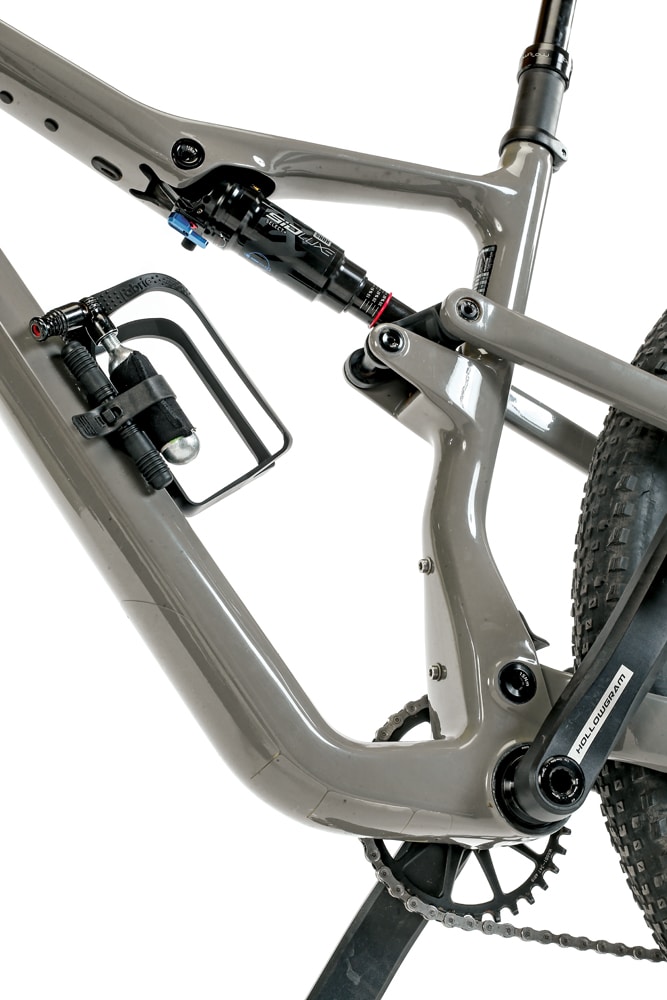Bike Review: Cannondale Scalpel Carbon Se 1 Trail Bike
Cannondale Scalpel Carbon Se 1
Utilitarian and practical options in the mountain bike world seem to be gaining more traction each year, bikes that can accommodate multiple needs, including trail riding with steep climbs, long adventures and even racing. Cannondale isn’t about to miss that boat in its clever, clean-cut fashion.
A direct descendent of the 100mm, lightweight, lefty Scalpel cross-country race bike, the SE has a few substantial differences, including a 1-degree-slacker head tube angle of 67 degrees and 120mm of front and rear travel, with the biggest standout being the non-Lefty fork. These features give the Scalpel SE a wider dynamic range, making it a bike we were excited to throw a leg over.
THE FRAME
Aesthetically, the carbon frame is pretty sharp-looking, with new-age curves from the head tube down to the shock mount. There is even a custom fabric multi-tool kit/carrier that also holds a CO2 and a DynaPlug. This system is called Stash and is located on the downtube right under the water-bottle cage. Also, there are mounts and space to fit two medium-sized water bottles nicely, which is a great benefit for racing or endurance rides. Of course, we can’t forget about the sleeved internal cable routing for easy replacement, as well as for keeping the cables from flopping around inside the frame.
Cannondale has a unique approach to the lower rear pivot, which it calls a BallisTec carbon FlexPivot. The idea is to avoid having to worry about replacing bushings or bearings while providing a small amount of flex for more of a compliant feel. Furthermore, in terms of the rear chainstay, you’ll notice an asymmetrical offset drivetrain that shortens the rear stay, making it stiffer. This stiffness is to send more positive energy to the rear wheel with every pedal stroke.
COMPONENTS
The Scalpel SE comes in four different builds ranging from $4300- $8250, including a lavender-colored women’s model. The SE 1 build we tested is a Shimanocomponents build, including XT brakes, derailleur and shifter. The discs are 160mm rear and 180mm in the front. The 12-speed XT has a wide-range, 11-51 cassette with a 32-tooth chainring that allows for an optimal dynamic range up and down the hill.
 A Shimano XT derailleur for smooth, precise shifting when you need it.
A Shimano XT derailleur for smooth, precise shifting when you need it.
Cannondale is using its house-brand HollowGram 25, Superlight Hi-Impact carbon rims that are fitted stock with 2.35-inch Maxxis Ardent Race tires up front, and 2.35-inch Maxxis Recon Race rubber in the rear; however, you will notice we went with something a little different on our test bike ( more on that in a bit). This medium option we tested comes with a 125mm Cannondale DownLow dropper post. The small comes with 100mm. The large has 125mm, and the XL comes with 150mm. The suspension duties are handled by a 120mm Rockshox SID Select fork and 120mm Rockshox SIDLuxe Select shock.
 The BallisTec FlexPivot design is intended to be free of shop service while still acting as a virtual Horst-link pivot.
The BallisTec FlexPivot design is intended to be free of shop service while still acting as a virtual Horst-link pivot.
SUSPENSION
Of course, Cannondale is known for unique suspension designs, most notably the Lefty design. In the case of the Scalpel SE, you’ll find something potentially more out of the ordinary for Cannondale—a standard fork. The standard fork will allow for a slightly more secure feeling on more aggressive, rougher sections and more predictable cornering as well.
 The Scalpel SE’s geometry will get you through long days of pedaling.
The Scalpel SE’s geometry will get you through long days of pedaling.
The 120mm of travel provides more versatile functionality for many different types of rides. As we mentioned, Cannondale’s design features FlexPivot “virtual links” located at the rear dropouts, which rely on the inherent flex (or bending) of slimmed-down carbon chainstays to help actuate the travel. Although you might not actually feel the flex, the bike does track exceptionally well through corners and on downhills. An interesting factor is that the kinematics of the suspension are specially engineered for each size frame with a unique and handy chart to guide you in setting the rear pressure for your weight.
 This Scalpel has the geometry feel of a more brawny trail bike but in a lighter, more flickable version.
This Scalpel has the geometry feel of a more brawny trail bike but in a lighter, more flickable version.
DOWN AND DIRTY
Cross-country bike? Yes. We had to remind ourselves several times, though, because it’s truly a bike that shines brighter than a (longer travel) XC race bike. Although you shouldn’t expect a full-send bomber-planted feel from the Scalpel SE, it is far more forgiving than the dedicated race bike. Having 120mm of trawl made rougher sections less fatiguing and provided more confidence, which allowed for more speed going downhill. Since the bike was so light, we had a blast hopping over rain ruts and banging through tight switchbacks.
CLIMBING
The gearing choice is just about perfect up or down, but the XT derailleur is exceptionally smooth going up when you need to get to that 51-tooth gear fast. Especially for our test grounds here in Southern California, the 32-tooth chainring combined with the 11-51 cassette is about the perfect setup. We have lots of long steep climbs out here, so it’s nice to have a 32-tooth chainring to be able to spin when you need to. It was comforting to have 120mm of rear travel when climbing nearly impossible climbs. The rear end soaks up loose rocks or ruts and allows the rear wheel to have more traction.
 The extra travel allows you to have fun on the trails but can be brought out for the local cross-country race and still be competitive.
The extra travel allows you to have fun on the trails but can be brought out for the local cross-country race and still be competitive.
THE FLOW
We stuck to the suggested RockShox pressure ratings for our rider weight, allowing the shock to do its job well. We used all of the 120mm of travel without any heavy bottoming out. This bike almost has the geometry feel of a beefy trail bike but in a lighter, more flickable version. This made going downhill an absolute blast! Having a dropper post also allows you to stay lower for longer technical descents, providing a more planted/safer feel. The XT brakes are some of our favorite brakes. They work as they should and remain consistent on longer descents.
![]() MODS AND UPGRADES
MODS AND UPGRADES
This is a pretty substantial build right out of the box, and for just above $6000, you definitely shouldn’t expect anything less. It’s mostly carbon to begin with, so the weight is already low out of the box. Flirting with a 34-tooth chainring would be beneficial in different areas for more top-end speed where steep climbs don’t exist. We did spin out on long, gradual descents occasionally. We ended up fitting the SE 1 with some Maxxis Dissector 2.4-inch tires, which provided added traction. They are not typically what we run on the front, but we were surprised by the overall traction and predictability. One other benefit, especially for racing, would be a remote lockout for the shock, although that will require upgrading to a whole different shock switch.
THE BOTTOM LINE
As a multi-dimensional bike that allows you to have fun on the trails but can be brought out for the local cross-country race and still be competitive, the Scalpel SE 1 is a solid option. No, it’s not the lightweight-edition Scalpel Ultimate that we tested in the December 2020 issue, but with the extra travel, you can get quite a bit rowdier.
Overall, it’s quite the Swiss Army knife on the trails. It’s important to note that you shouldn’t expect the slam-ability of a heavier trail bike; however, you will find much more comfort and predictability than with the superlight, shorter-travel version.
www.cannondale.com
SUBSCRIBE & RENEW HERE
For more subscription information contact (800) 767-0345











